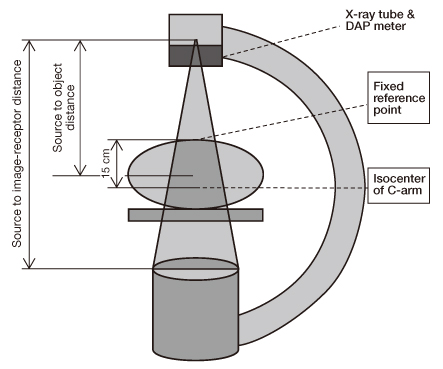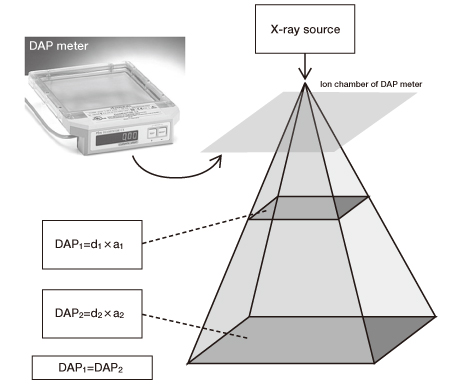J Korean Med Assoc.
2011 Dec;54(12):1269-1276. 10.5124/jkma.2011.54.12.1269.
Radiation exposure and its reduction in the fluoroscopic examination and fluoroscopy-guided interventional radiology
- Affiliations
-
- 1Department of Radiology, Hanyang University Guri Hospital, Hanyang University College of Medicine, Guri, Korea. jeongwk@hanyang.ac.kr
- KMID: 2064777
- DOI: http://doi.org/10.5124/jkma.2011.54.12.1269
Abstract
- Radiation exposure during fluoroscopy has been of consistent interest because fluoroscopy is used not only for diagnostic purposes such as upper gastrointestinal series but for many minimally-invasive treatments in various clinical fields. In 2000, the International Commission on Radiological Protection published the important report about the avoidance of radiation injuries from medical interventional procedures, and this report defined harm during fluoroscopic-guided interventional procedure and how to reduce the radiation dose of patients and staff. Two aspects of fluoroscopy exposure differ from other types of medical radiation exposure, including computed tomography. One is that the entrance surface dose during an interventional procedure may be very high, so the deterministic effects of radiation such as skin or corneal injury should be emphasized more than stochastic effects such as cancer risk. The other is that the variation in radiation exposure is great for the same kind of procedure, so it is very difficult to generate a reference level for the radiation dose. Therefore, it is necessary to develop a guideline for the use of fluoroscopy through a nationwide survey about irradiation during fluoroscopic examinations and fluoroscopy-guided intervention procedures. In conclusion, radiation exposure by fluoroscopic guided intervention is not negligible, and the practitioner should always aim to reduce radiation exposure during interventional procedures.
Keyword
MeSH Terms
Figure
Cited by 1 articles
-
A Randomized Controlled Trial about the Levels of Radiation Exposure Depends on the Use of Collimation C-arm Fluoroscopic-guided Medial Branch Block
Seung Woo Baek, Jae Sung Ryu, Cheol Hee Jung, Joo Han Lee, Won Kyoung Kwon, Nam Sik Woo, Hae Kyoung Kim, Jae Hun Kim
Korean J Pain. 2013;26(2):148-153. doi: 10.3344/kjp.2013.26.2.148.
Reference
-
1. Schauer DA, Linton OW. NCRP report no. 160. Ionizing radiation exposure of the population of the United States, medical exposure: are we doing less with more, and is there a role for health physicists? Health Phys. 2009. 97:1–5.
Article2. Balter S, Hopewell JW, Miller DL, Wagner LK, Zelefsky MJ. Fluoroscopically guided interventional procedures: a review of radiation effects on patients' skin and hair. Radiology. 2010. 254:326–341.
Article3. Koenig TR, Wolff D, Mettler FA, Wagner LK. Skin injuries from fluoroscopically guided procedures: part 1, characteristics of radiation injury. AJR Am J Roentgenol. 2001. 177:3–11.4. Koenig TR, Mettler FA, Wagner LK. Skin injuries from fluoroscopically guided procedures: part 2, review of 73 cases and recommendations for minimizing dose delivered to patient. AJR Am J Roentgenol. 2001. 177:13–20.5. Valentin J. Avoidance of radiation injuries from medical interventional procedures. Ann ICRP. 2000. 30:7–67.
Article6. Mettler FA Jr, Huda W, Yoshizumi TT, Mahesh M. Effective doses in radiology and diagnostic nuclear medicine: a catalog. Radiology. 2008. 248:254–263.
Article7. Jaco JW, Miller DL. Measuring and monitoring radiation dose during fluoroscopically guided procedures. Tech Vasc Interv Radiol. 2010. 13:188–193.
Article8. Bor D, Sancak T, Olgar T, Elcim Y, Adanali A, Sanlidilek U, Akyar S. Comparison of effective doses obtained from dose-area product and air kerma measurements in interventional radiology. Br J Radiol. 2004. 77:315–322.
Article9. Ruiz Cruces R, Garcia-Granados J, Diaz Romero FJ, Hernandez Armas J. Estimation of effective dose in some digital angiographic and interventional procedures. Br J Radiol. 1998. 71:42–47.
Article10. McParland BJ. A study of patient radiation doses in interventional radiological procedures. Br J Radiol. 1998. 71:175–185.
Article11. Vano E, Gonzalez L, Fernandez JM, Guibelalde E. Patient dose values in interventional radiology. Br J Radiol. 1995. 68:1215–1220.
Article12. Marshall NW, Noble J, Faulkner K. Patient and staff dosimetry in neuroradiological procedures. Br J Radiol. 1995. 68:495–501.
Article13. Balter S, Schueler BA, Miller DL, Cole PE, Lu HT, Berenstein A, Albert R, Georgia JD, Noonan PT, Russell EJ, Malisch TW, Vogelzang RL, Geisinger M, Cardella JF, St George J, Miller GL 3rd, Anderson J. Radiation doses in interventional radiology procedures: the RAD-IR Study. Part III: Dosimetric performance of the interventional fluoroscopy units. J Vasc Interv Radiol. 2004. 15:919–926.14. Miller DL, Balter S, Cole PE, Lu HT, Schueler BA, Geisinger M, Berenstein A, Albert R, Georgia JD, Noonan PT, Cardella JF, St George J, Russell EJ, Malisch TW, Vogelzang RL, Miller GL 3rd, Anderson J. RAD-IR study. Radiation doses in interventional radiology procedures: the RAD-IR study: part I: overall measures of dose. J Vasc Interv Radiol. 2003. 14:711–727.
Article15. Miller DL, Balter S, Cole PE, Lu HT, Berenstein A, Albert R, Schueler BA, Georgia JD, Noonan PT, Russell EJ, Malisch TW, Vogelzang RL, Geisinger M, Cardella JF, George JS, Miller GL 3rd, Anderson J. Radiation doses in interventional radiology procedures: the RAD-IR study: part II: skin dose. J Vasc Interv Radiol. 2003. 14:977–990.
Article16. Miller DL, Kwon D, Bonavia GH. Reference levels for patient radiation doses in interventional radiology: proposed initial values for U.S. practice. Radiology. 2009. 253:753–764.
Article17. Chung JW. Korea Food & Drug Administration. Evaluation of patient dose in interventional radiology. 2007. Seoul: Korea Food & Drug Asministration.18. Schueler BA. Operator shielding: how and why. Tech Vasc Interv Radiol. 2010. 13:167–171.
Article19. National Council on Radiation Protection and Managements. Limitation of exposure to ionizaing radiation: NCRP report no. 116. 1993. Bethesda: National Council on Radiation Protection and Measurements.20. Klein LW, Miller DL, Balter S, Laskey W, Haines D, Norbash A, Mauro MA, Goldstein JA. Occupational health hazards in the interventional laboratory: time for a safer environment. Radiology. 2009. 250:538–544.
Article21. Finkelstein MM. Is brain cancer an occupational disease of cardiologists? Can J Cardiol. 1998. 14:1385–1388.22. Matanoski GM, Seltser R, Sartwell PE, Diamond EL, Elliott EA. The current mortality rates of radiologists and other physician specialists: specific causes of death. Am J Epidemiol. 1975. 101:199–210.
Article23. 10 Pearls: radiation protection of patients in fluoroscopy [Internet]. International Atomic Energy Agency Radiation Protection of Patients. cited 2011 Nov 18. Vienna: International Atomic Energy Agency;Available from: https://rpop.iaea.org/RPOP/RPoP/Content/Documents/Whitepapers/posterpatient-radiation-protection.pdf.24. 10 Pearls: radiation protection of staff in fluoroscopy [Internet]. International Atomic Energy Agency Radiation Protection of Patients. cited 2011 Nov 18. Vienna: International Atomic Energy Agency;Available from: https://rpop.iaea.org/RPOP/RPoP/Content/Documents/Whitepapers/poster-staff-radiationprotection.pdf.
- Full Text Links
- Actions
-
Cited
- CITED
-
- Close
- Share
- Similar articles
-
- Radiation safety for pain physicians: principles and recommendations
- Radiation safety: a focus on lead aprons and thyroid shields in interventional pain management
- Fluoroscopy-induced Chronic Radiation Dermatitis
- Fluoroscopy-induced Subacute Radiation Dermatitis in Patient with Hepatocellular Carcinoma
- Radiation Exposure to Physicians During Interventional Pain Procedures



